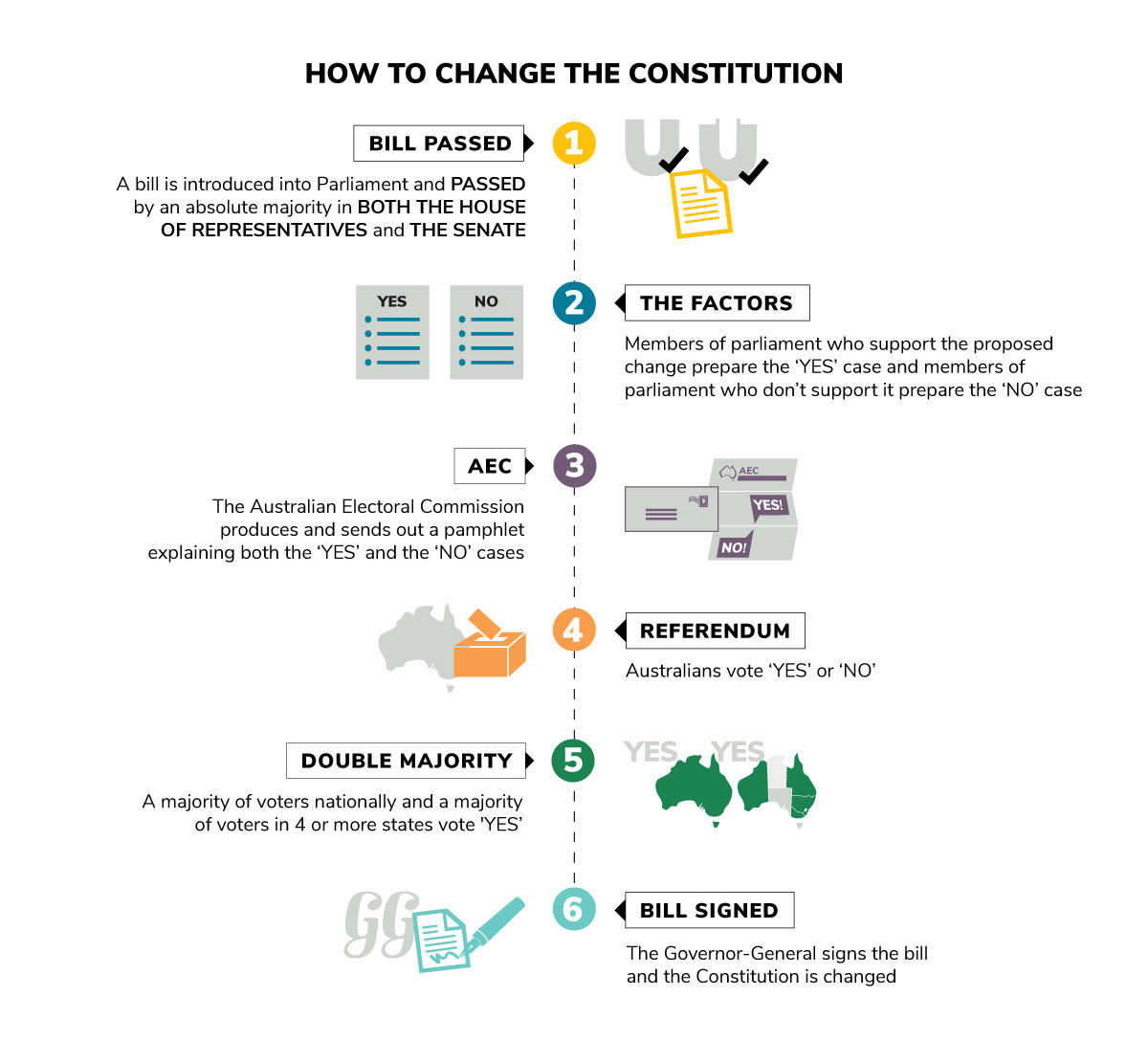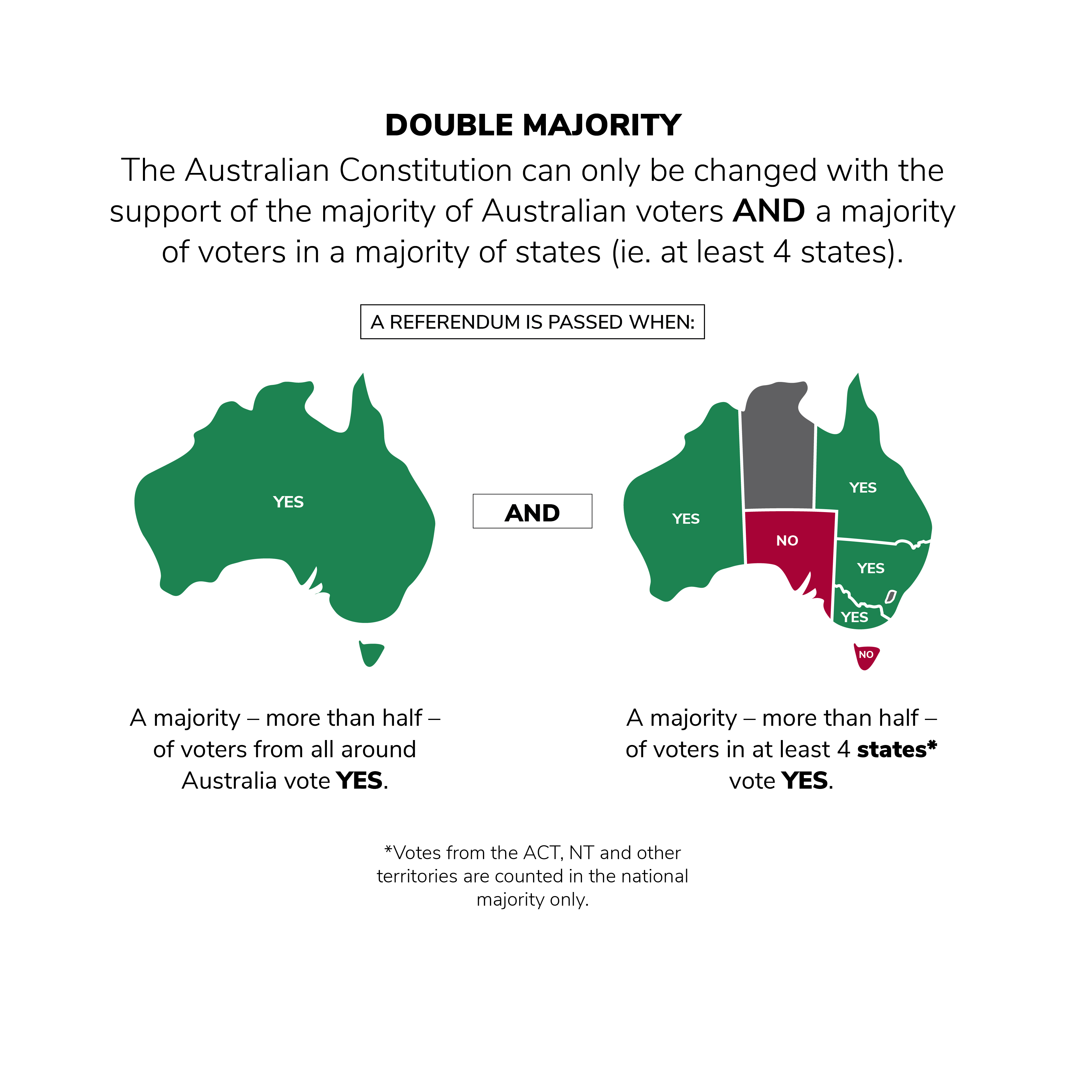Referendums and plebiscites
A referendum is a vote of the Australian people on a proposed change to the Australian Constitution, while a plebiscite is a vote on an issue that does not affect the Constitution. This fact sheet explores the process of referendums and plebiscites in Australia.
What will I learn?
- A referendum is a vote on a proposed change to the Australian Constitution.
- A referendum is passed if it is approved by a double majority.
- A plebiscite is a national vote on a question that does not affect the Constitution.
Curriculum alignment
Year 7 ACHCK049
What is a referendum?
A referendum is a vote by the Australian people on a proposed change to the Australian Constitution. Section 128 of the Constitution explains the process of holding a referendum and the way a referendum is passed.
How to change the Australian Constitution.

Parliamentary Education Office (PEO.GOV.AU)
Description
This graphic explains the steps that need to be taken before the Australian Constitution can be changed:
1. Bill passed
- A bill is introduced into Parliament and PASSED by an absolute majority in bother House of Representatives and the Senate.
2. The factors
- Members of parliament who support the proposed change prepare the 'YES' case and members of parliament who don't support it prepare the 'NO' case.
3. AEC
- the Australian Electoral Commission produces and sends out a pamphlet explaining both the 'YES' and the 'NO' cases.
4. Referendum
- Australians vote 'YES' or 'NO'.
5. Double Majority
- A majority of voters nationally and a majority of voters in 4 or more states vote 'YES'
6. Bill signed
- The Governor-General signs the bill and the Constitution is changed
Copyright information
This work is licensed under a Creative Commons Attribution-NonCommercial-NoDerivs 3.0 Unported License.
You are free to share – to copy, distribute and transmit the work.
Attribution – you must attribute the work in the manner specified by the author or licensor (but not in any way that suggests that they endorse you or your use of the work).
Non-commercial – you may not use this work for commercial purposes.
No derivative works – you may not alter, transform, or build upon this work.
Waiver – any of the above conditions can be waived if you get permission from the copyright holder.
Referendum process
How to change the Australian Constitution.

Parliamentary Education Office (PEO.GOV.AU)
Description
This graphic explains the steps that need to be taken before the Australian Constitution can be changed:
1. Bill passed
- A bill is introduced into Parliament and PASSED by an absolute majority in bother House of Representatives and the Senate.
2. The factors
- Members of parliament who support the proposed change prepare the 'YES' case and members of parliament who don't support it prepare the 'NO' case.
3. AEC
- the Australian Electoral Commission produces and sends out a pamphlet explaining both the 'YES' and the 'NO' cases.
4. Referendum
- Australians vote 'YES' or 'NO'.
5. Double Majority
- A majority of voters nationally and a majority of voters in 4 or more states vote 'YES'
6. Bill signed
- The Governor-General signs the bill and the Constitution is changed
Copyright information
This work is licensed under a Creative Commons Attribution-NonCommercial-NoDerivs 3.0 Unported License.
You are free to share – to copy, distribute and transmit the work.
Attribution – you must attribute the work in the manner specified by the author or licensor (but not in any way that suggests that they endorse you or your use of the work).
Non-commercial – you may not use this work for commercial purposes.
No derivative works – you may not alter, transform, or build upon this work.
Waiver – any of the above conditions can be waived if you get permission from the copyright holder.
A proposed change to the Constitution must start as a bill – proposed law – in the Australian Parliament. An absolute majority – more than half of the total number – of senators and members of the House of Representatives must vote for the bill. The referendum must take place between 2 and 6 months after the bill is passed.
If the Senate and House cannot agree on the bill, Section 128 of the Constitution provides a way for a referendum to still be held.
Before a referendum is held, arguments for or against the proposed change are prepared. Members of parliament who voted for the bill prepare the ‘Yes’ case and those who voted against the bill prepare the ‘No’ case. The Australian Electoral Commission (AEC) publishes these arguments together with the proposed change and sends it to all households with an enrolled voter in Australia.
Voting in a referendum is similar to voting in a federal election. Polling places are set up at schools and other public buildings around the country. Voting in a referendum is compulsory for Australian citizens 18 years and over. When they vote, each person’s name is marked off the electoral roll and they are given a ballot paper. Voters write on their ballot paper ‘Yes’ if they approve the proposed change to the Constitution or ‘No’ if they do not approve it.
Changing the Australian Constitution – double majority.

Parliamentary Education Office (peo.gov.au)
Description
This image shows how the Australian Constitution can only be changed with the support of the majority of Australian voters and the majority of voters in the majority of states (ie at least 4 states).
Votes from the ACT, NT and other territories are counted in the national majority only.
Copyright information
This work is licensed under a Creative Commons Attribution-NonCommercial-NoDerivs 3.0 Unported License.
You are free to share – to copy, distribute and transmit the work.
Attribution – you must attribute the work in the manner specified by the author or licensor (but not in any way that suggests that they endorse you or your use of the work).
Non-commercial – you may not use this work for commercial purposes.
No derivative works – you may not alter, transform, or build upon this work.
Waiver – any of the above conditions can be waived if you get permission from the copyright holder.
Referendum results
Changing the Australian Constitution – double majority.

Parliamentary Education Office (peo.gov.au)
Description
This image shows how the Australian Constitution can only be changed with the support of the majority of Australian voters and the majority of voters in the majority of states (ie at least 4 states).
Votes from the ACT, NT and other territories are counted in the national majority only.
Copyright information
This work is licensed under a Creative Commons Attribution-NonCommercial-NoDerivs 3.0 Unported License.
You are free to share – to copy, distribute and transmit the work.
Attribution – you must attribute the work in the manner specified by the author or licensor (but not in any way that suggests that they endorse you or your use of the work).
Non-commercial – you may not use this work for commercial purposes.
No derivative works – you may not alter, transform, or build upon this work.
Waiver – any of the above conditions can be waived if you get permission from the copyright holder.
Section 128 of the Constitution says a referendum is passed if it is approved by a majority of voters across the nation and a majority of voters in a majority of states — a double majority. A double majority makes sure there is support across the country and that voters within every state, regardless of their population, have an equal say on the change. The votes of people in the Australian Capital Territory and Northern Territory are only counted in the national vote.
If a referendum is approved by a double majority, the change is made to the Constitution. If the double majority is not reached, the referendum has not passed, and the Constitution is not changed.
Since 1901 there have been 45 proposed changes to the Constitution. Eight changes have been agreed to by the Australian people at a referendum.
What is a plebiscite?
A plebiscite is a national vote to decide a question that does not affect the Constitution. It can be used to test whether the government has enough public support to go ahead with an idea. A plebiscite does not have any legal force. There are no rules about how to run a plebiscite in the Constitution. If a plebiscite is held, the Parliament decides on how it is run.
There were 2 national plebiscites held during the First World War in Australia. In 1916 and 1917 voters were asked if they supported conscription. In both plebiscites, Australians voted against conscription. In 1977, Australians were polled on which song they preferred as the national song. Advance Australia Fair was chosen.
The government can use other methods to see if ideas have public support. In 2017, a postal survey asked Australians if they supported legalising same-sex marriage in Australia.
Can you make a double majority?
NO
Referendum not passed
Australian Constitution stays the same
Australian Constitution stays the same
